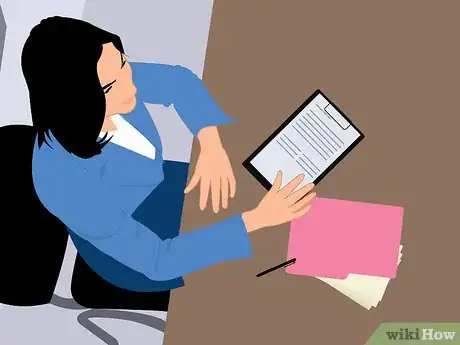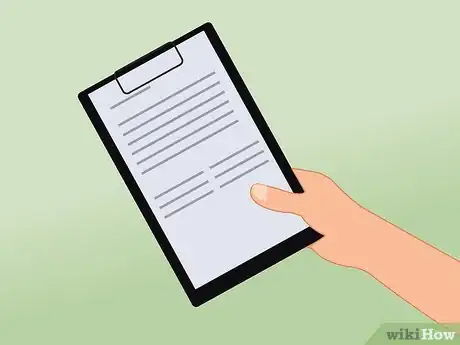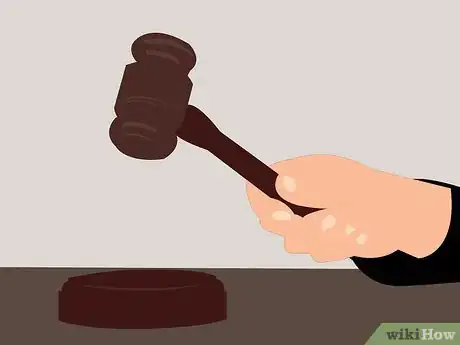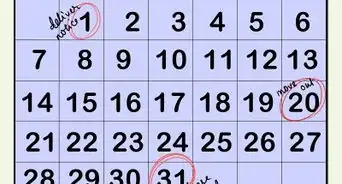This article was written by Jennifer Mueller, JD. Jennifer Mueller is an in-house legal expert at wikiHow. Jennifer reviews, fact-checks, and evaluates wikiHow's legal content to ensure thoroughness and accuracy. She received her JD from Indiana University Maurer School of Law in 2006.
There are 19 references cited in this article, which can be found at the bottom of the page.
This article has been viewed 147,856 times.
Most landlords aren't out to cheat you out of money. Despite this, unfair charges – whether for damages or other fees – are an all-too-common occurrence. Often, landlords simply charge these damages because they can, expecting few tenants to fight them. The good news is that if you understand your rights and thoroughly document your claim, you can dispute unfair landlord charges and come out on top.[1] [2]
Steps
Sending a Demand Letter
-
1Draft a formal business letter. You need to create a paper trail to dispute unfair landlord charges, so you have evidence to back up your claims if you end up having to sue. For this reason, you need to prepare a formal business letter that you can mail to your landlord.[3] [4]
- You can find a blank template for a business letter on whatever word processing application you use.
- There also are sample form letters available on the internet that can help you formulate and focus the substance of your letter. Look on legal forms websites as well as websites for tenants' rights organizations in your state.
- If you're using a form letter created by an organization in another state, be careful about copying statements verbatim that refer to the law or something being illegal. Since landlord-tenant law fluctuates, this may not be true in your state.
-
2Include a factual breakdown of the dispute. Your letter must include factual specifics. While it's not necessary to quote or cite your state's landlord-tenant law, it won't hurt to include this information if you know it and it supports your argument.[5] [6] [7]
- Many tenants' rights organizations have breakdowns of state law in plain language. However, make sure you're looking at information from an organization located in your state – don't rely on information from an organization located elsewhere.
- Begin your letter by recounting specific facts, including the date you moved out of your apartment and how long you lived there. You also want to include any letters or statements you received from your landlord, and the dates on those letters.
- Describe the general condition in which you left your apartment and any steps you took to clean or repair the unit before you left. For example, if you paid to have the apartment professionally cleaned, state this along with the date of the cleaning and the name of the service you used.
Advertisement -
3Make specific demands. Once you've broken down the charges in your letter exactly as the landlord did, explain what you will and will not pay. Keep in mind that you're probably not going to get very far by refusing to pay anything at all and demanding your entire deposit back.[8] [9] [10]
- State clearly that you have no intention of paying the amount your landlord has charged you. For example, you might write "I will not pay the $1,500 you charged me in damages because these charges are unfair for the reasons described above. I am, however, willing to pay $200 for the damages to the bedroom carpet caused by my dog."
- If your landlord has charged you excessive amounts for damages to your apartment after you moved out, take an honest and objective look at the state of your apartment and determine the amount that would be reasonable to pay.
- In all states, landlords are not allowed to charge you for damages that constitute "normal wear and tear" to the premises. The longer you lived there, the more wear and tear there will be.
- For example, if you lived in an apartment for five years, it is unfair for the landlord to charge you to repaint the apartment. Five years is beyond the useful life for paint.
- You also should keep in mind that small damages, such as thumbtack holes in the wall where you hung up pictures on the walls, typically are considered normal wear and tear and not something for which your landlord should charge you to repair.
-
4Set a deadline for response. Provide your landlord with a reasonable period of time to evaluate the facts and claims in your letter and adjust the charges before you escalate the situation. Let your landlord know what will happen if your demands aren't met by that date.[11]
- Five to ten business days from the date the landlord receives your letter typically is considered a reasonable period of time.
- However, you may want to shorten this period if your landlord intends to charge you late fees, or has stated that the amount you owe is due immediately.
- State specifically what you'll do if the landlord doesn't meet your demands by the deadline, but avoid making threats you don't have any intention of keeping.
- If you haven't yet decided what you want to do if the landlord refuses, you can simply say "If I don't hear from you by the close of business within three days of receipt of this letter, I'll be forced to examine further options."
-
5Gather supporting evidence. If you have any documents or photos that back up your claims, you should attach those to your letter before sending it to your landlord. Make sure you're sending copies of the originals, keeping the originals themselves for your own records.[12] [13]
- For example, if you took pictures of your apartment before you moved out, you may want to print and attach copies of these pictures.
- Photos are even more valuable evidence if you also took pictures when you moved in that you can set up as a side-by-side comparison with the move-out pictures. Include date stamps on the images you include.
- If you referenced any state landlord-tenant law in your letter, include a copy of the law itself or a print-out of the web page you used that had a summary of that law. Don't assume your landlord will know what the law says.
- Receipts or invoices may be appropriate supporting evidence if, for example, you paid an independent company to professionally clean your apartment and your landlord is attempting to charge you for professional cleaning.
- Receipts or cancelled checks also can be helpful if your landlord is charging you for rent you already paid, or other bills for which you've already made payment.
-
6Mail your letter. Even if it would be a fairly simple matter to simply hand the letter to your landlord, remember that you are creating a chain of evidence for later use if your landlord refuses to reduce or eliminate the unfair charges.[14]
- The best way to do this is to mail your letter using certified mail with returned receipt requested. Ask for it at your local post office.
- Before you mail your letter, make sure you have at least one copy of it for your records, along with any documents you attached.
- Your landlord must sign for the letter when it is received. A green card is then returned to you showing your landlord's signature and the date the letter was received.
- Count out your deadline from the date of receipt and mark it on your calendar. Save the green card if you later need to prove that you sent a demand letter to your landlord and they didn't reply or refused to work with you.
Attempting Mediation
-
1Find a community mediation center. Most areas, particularly cities, have community mediation centers that provide relatively low-cost mediation services for common disputes such as landlord-tenant issues.[15]
- To find a community mediation center, check the website of your state or local bar association and look for a mediation services link. The clerk's office of your county court may have similar information.
- Some tenants' rights organizations also have information for mediating landlord-tenant disputes, or provide mediation services themselves.
- Many of these centers are sponsored by the bar association or state government to provide low-cost means for people to settle their disputes without going to court.
- Mediation is a voluntary, confidential process that focuses on meaningful negotiation towards a mutually acceptable settlement of a dispute in a non-adversarial setting.
-
2Notify your landlord. Since mediation is a voluntary means of resolving your dispute, your landlord must agree to submit the dispute to mediation. The mediation center may have a form that you can complete and send to your landlord to let them know you want to attempt to resolve the dispute using mediation.[16]
- Some mediation centers may contact your landlord for you to set up the appointment. Typically you give a range of dates and times that would work for you, and then the center contacts your landlord with those options.
- Once your landlord responds and agrees to use mediation, an appointment will be set for your session.
- The center may have additional forms for you to read and sign that explain a little bit more about the mediation process and the ground rules for the session.
-
3Prepare for your mediation session. Before your mediation session, outline your arguments and think about what you're willing to accept as a compromise to end the dispute. While mediation is far less formal than a courtroom trial, you typically are allowed to bring any evidence or witnesses you have to support your claims.[17]
- If you have witnesses, you typically can bring them along with you to your mediation session. You also might want to bring a friend or family member along for moral support.
- If someone else signed your lease, such as a spouse, partner, or roommate, you probably should alert them to the mediation session and have them plan to be there.
- You are allowed to have an attorney at mediation, but an attorney isn't necessary. Even if your landlord will be appearing with an attorney, the mediator will make sure everyone is fairly represented and has an equal opportunity to negotiate and have their voice heard.
- In advance, think about what you want out of mediation and set your own negotiating range. You can think of this in terms of two values: the ideal minimum amount you want to pay (which may well be zero) and the most you're willing to pay.
-
4Attend your mediation session. The mediation session typically will be held at the center itself, and begin with everyone meeting in the same room. The mediator will introduce him- or herself and explain the basic procedures and rules governing the session.[18]
- The mediator typically then gives each side the opportunity to state their case and explain what they want out of mediation. This is basically a summary of your arguments and why you believe your landlord's charges are unfair.
- After your opening statements, the mediator typically will move you and your landlord to separate rooms, where he or she will have a private conversation regarding the dispute and your arguments against the charges.
- Everything you say to the mediator will be held in confidence, and generally will not be repeated – even to your landlord – unless the mediator first asks your permission. In this environment, you can fill free to be open and honest with the mediator.
-
5Negotiate with your landlord. The mediator typically facilitates negotiations while you and your landlord remain in separate rooms. This makes the process less confrontational and intimidating than if you attempted to negotiate face to face.[19]
- The mediator will try to get to the root of the dispute. For example, it may have been that your landlord charged you excessive damages because a neighbor had made several complaints about you.
- At any point during negotiations, you can bring up any witnesses or evidence you have that supports your arguments.
- For example, if your landlord refuses to budge on carpet replacement charges because she asserts you damaged the carpet, you might show photos you took when you moved in and when you moved out that show the carpet to be in similar condition.
- If the mediator feels that you've found some common ground and are close to reaching a mutually agreeable settlement, you and your landlord may return to the single room where the session first started.
- On the other hand, if you aren't able to reach a compromise, the mediator will declare an impasse.
- Typically at this point you'll get a statement from the mediator that explains what, if anything, you and your landlord were able to agree on, and where negotiations got stuck.
-
6Get any settlement in writing. Mediation proceedings are voluntary, which means there's no requirement that you come to any agreement at all. However, if you do settle the dispute, the terms of that settlement become legally binding once put into writing and signed by both parties.[20]
- Typically the mediator will write up a settlement agreement for you. Read it carefully before you sign it to make sure it reflects the same terms to which you thought you were agreeing.
- Once you and your landlord have signed the settlement agreement, it becomes a legally binding contract that you can enforce in court if the landlord doesn't live up to their side of the bargain.
Suing in Small Claims
-
1Locate the correct court. Typically the charges you dispute will be low enough to fall below your state's small-claims threshold. The court where you file your claim will most likely be the one in the county where your rental unit is located.[21] [22]
- Keep in mind that a court's jurisdiction is determined by where the dispute took place or the location of the person or business you're suing.
- This means if you've since moved to a different state or county, you may need to return to your old county of residence to file a lawsuit against your former landlord.
- You can only sue for monetary damages in small claims court, and there's a maximum amount – although it varies greatly among states. In some states it may be as high as $10,000, but in most it's around $5,000.
- You may have to pay the amount your landlord claims you owe before you file your lawsuit. Then you can file a claim arguing the charges were unfair and demand repayment.
- Some states, however, may allow you to file your claim before you've paid the amount demanded by your landlord.
- Small claims courts have simple procedures and are designed so that you can represent yourself rather than having to hire an attorney. In fact, some states don't even allow attorneys to practice in small claims courts.
-
2Complete your claim forms. Each small claims court has its own fill-in-the-blank forms that you can use to start the court process. Some courts may make these forms available online, or you can get paper forms to use by visiting the clerk's office.[23] [24]
- The form will require basic identification information about yourself and your landlord.
- You also must provide a detailed factual description of the dispute and what you want the court to do.
- You need to include as many facts as possible, including the date you moved into your rental unit and the date you moved out.
- You also may need to attach a copy of your lease to your claim form, if your tenancy was covered by a written lease.
- Some states require you to demonstrate to the small claims court that you made some effort to resolve the dispute before filing your claim. If you sent a demand letter to your landlord, a copy of that letter along with your card showing the letter was received is sufficient.
- If you attempted mediation and were unable to reach a resolution, you might want to include a copy of any statement from the mediator as well.
-
3File your claim forms. Once you've filled out your claim forms completely, give them to the small claims court clerk to initiate your lawsuit. In addition to your original forms, you'll need to take at least two copies – one for your landlord and one for your own records.[25] [26]
- Keep in mind that while the clerk can make copies of the claim forms for you, they'll typically charge you a small fee for that service.
- You also must pay a filing fee to initiate your small claims suit – typically around $100 or less. If you are unable to afford the filing fees, ask the clerk for a fee waiver affidavit.
- On the affidavit, you'll have to provide information about your income and assets. If those fall below the court's threshold, or if you receive public benefits, you may not have to pay court costs for your claim.
-
4Have your landlord served. After you've filed your claim, your landlord must have legal notice that they've been sued. Each court has a specific process that you must follow, known as "service," that allows you to prove that your landlord had notice of your claim.[27] [28]
- Technically, you can complete service by having anyone over the age of 18 who isn't involved in your claim hand-deliver the claim forms to your landlord.
- That person then must complete a proof of service form for you to file with the court clerk. These are standard forms that typically are available in the clerk's office.
- There are two other ways to have documents served. You can pay a small fee to a sheriff's deputy or a private process server to hand-deliver the documents to your landlord, or you can mail them using certified mail.
- If you use certified mail, save the green card you get back when the documents are received and use it to complete the proof of service form.
-
5Gather evidence to support your claim. The more solid evidence you have to back up your claim that your landlord's charges are unfair, the more likely the judge will be to rule in your favor. Bring originals of anything you want to submit to the court as evidence.[29] [30] [31]
- If you have photos as part of your evidence, be prepared to authenticate them if you want them admitted into evidence. If you took the photos yourself, you can do this by your own testimony.
- You also will need to bring your copy of your claim forms and any other documents, such as your lease or your demand letter, that you attached to your claim when you filed it.
- Since you typically will be expected to make an opening statement to the judge about your claim, you may want to prepare a short written statement or outline that describes the dispute and how you want the judge to rule.
-
6Attend your hearing. On the date scheduled, the judge will hear from both you and your landlord regarding the charges you're disputing. Try to arrive at the courthouse at least 30 minutes early so you have time to go through courthouse security and find the correct courtroom.[32] [33] [34]
- Depending on the court, you may have an initial hearing to determine whether your landlord intends to fight your claim. The judge typically won't evaluate your claim at this hearing.
- However, if your court does have an initial hearing and your landlord fails to appear, you may be entitled to receive a default judgement.
- You will have to prove to the judge that you are entitled to the specific amount of money you've demanded in your claim, so bring any receipts or other information that justifies that amount.
-
7Present your evidence. At the main hearing, the judge will call on you to tell your story and show the court why you are entitled to the amount of money you claim. Typically you can introduce evidence such as documents or photos as well as call witnesses.[35] [36]
- If you do call witnesses, you will ask them questions to draw out their testimony regarding the dispute. The judge also may ask them questions. Your landlord will get a chance to ask them questions too, through a process known as "cross examination."
- Keep your evidence and your statements focused on the facts regarding the dispute. For example, if your landlord has over-charged you for damages, you might present photos documenting the condition of your apartment when you moved out, or receipts that show you paid a professional cleaner to come in and clean the apartment.
- When you speak in court, speak directly to the judge – not to your landlord. While you may be angry, avoid insulting or shouting at your landlord in court.
- If the judge interrupts you and asks a question, stop and listen. Respond to the judge before you continue. Don't be afraid to ask the judge for clarification if he or she says something you don't understand.
- Once you've introduced all of your evidence, your landlord will have the opportunity to present his or her defense under the same procedures you followed to tell your side of the story. Avoid interrupting your landlord, even if you disagree with something they say.
-
8Receive the judge's ruling. The judge may make a ruling from the bench immediately after hearing from you and your landlord. However, you may have to wait a day or two before you can get the written order in your case.[37] [38]
- The judge typically will let you know what you should do following the ruling. In some states, the person who bought the claim isn't allowed to appeal the judge's decision if it isn't in their favor – only the defendant is.
- If the judge rules in your favor, you will receive information – either from the judge or from the court clerk – regarding what you must do to enforce the judgement. Keep in mind that even if you win, the court won't collect any money for you.
- When you get your copy of the written decision, make a couple of copies of it so you have it for your records.
References
- ↑ http://www.caltenantlaw.com/secdep.htm
- ↑ http://www.housing.ucsb.edu/files/docs/residences/success-guide/sg-securitydepositdispute.pdf
- ↑ http://www.ostendorflaw.com/blog/?p=233
- ↑ http://www.nolo.com/legal-encyclopedia/free-books/small-claims-book/chapter20-2.html
- ↑ http://www.nolo.com/legal-encyclopedia/free-books/small-claims-book/chapter20-2.html
- ↑ https://www.freeadvice.com/legal/sample-letter-to-landlord-improper-deductions-or-over-charges-from-security-deposit-for-normal-wear-and-tear/
- ↑ http://www.tenantsunion.org/en/rights/faq/deposits
- ↑ http://www.nolo.com/legal-encyclopedia/free-books/small-claims-book/chapter20-2.html
- ↑ https://www.freeadvice.com/legal/sample-letter-to-landlord-improper-deductions-or-over-charges-from-security-deposit-for-normal-wear-and-tear/
- ↑ http://www.tenantsunion.org/en/rights/faq/deposits
- ↑ https://www.freeadvice.com/legal/sample-letter-to-landlord-improper-deductions-or-over-charges-from-security-deposit-for-normal-wear-and-tear/
- ↑ http://www.ostendorflaw.com/blog/?p=233
- ↑ http://www.housing.ucsb.edu/files/docs/residences/success-guide/sg-securitydepositdispute.pdf
- ↑ https://www.freeadvice.com/legal/sample-letter-to-landlord-improper-deductions-or-over-charges-from-security-deposit-for-normal-wear-and-tear/
- ↑ http://www.lasvegasjusticecourt.us/services/neighborhood_justice_center/community_mediation.php
- ↑ http://www.nolo.com/legal-encyclopedia/free-books/renters-rights-book/chapter13-2.html
- ↑ http://www.nolo.com/legal-encyclopedia/free-books/renters-rights-book/chapter13-2.html
- ↑ http://www.nolo.com/legal-encyclopedia/mediation-six-stages-30252.html
- ↑ http://www.nolo.com/legal-encyclopedia/free-books/renters-rights-book/chapter13-2.html
- ↑ http://www.nolo.com/legal-encyclopedia/mediation-six-stages-30252.html
- ↑ http://www.tenantsunion.org/en/rights/how-to-use-small-claims-court
- ↑ http://www.nolo.com/legal-encyclopedia/free-books/renters-rights-book/chapter13-4.html
- ↑ http://www.courts.ca.gov/9744.htm
- ↑ http://www.seminoleclerk.org/FeesAndForms/public-forms/small-claims-book.pdf
- ↑ http://www.courts.ca.gov/9743.htm
- ↑ http://www.seminoleclerk.org/FeesAndForms/public-forms/small-claims-book.pdf
- ↑ http://www.courts.ca.gov/9742.htm
- ↑ http://www.seminoleclerk.org/FeesAndForms/public-forms/small-claims-book.pdf
- ↑ http://www.nolo.com/legal-encyclopedia/free-books/small-claims-book/chapter20-2.html
- ↑ http://www.caltenantlaw.com/secdep.htm
- ↑ http://www.courts.ca.gov/1013.htm
- ↑ http://www.courts.ca.gov/1013.htm
- ↑ http://www.courts.ca.gov/1119.htm
- ↑ http://www.seminoleclerk.org/FeesAndForms/public-forms/small-claims-book.pdf
- ↑ http://www.courts.ca.gov/1119.htm
- ↑ http://www.seminoleclerk.org/FeesAndForms/public-forms/small-claims-book.pdf
- ↑ http://www.courts.ca.gov/1120.htm
- ↑ http://www.nolo.com/legal-encyclopedia/free-books/small-claims-book/chapter23-4.html
About This Article
In order to dispute unfair landlord charges, you need to be able to document your claim whenever you make your dispute. Draft a formal business letter to your landlord so you can create a paper trail that backs up your claims if you end up having to sue them. In the letter, include a breakdown of the facts including the date you moved out and the condition of the house or apartment when you left. Use clear language to explain what you will and will not pay. For example, you could say, "I will not pay the $1,000 you charged for damages, but I will pay $100 for the carpet cleaning you paid for.” Give your landlord a deadline of up to 10 business days to respond. To learn about how to dispute landlord charges in small claims court, read more from our Legal co-author!












































































